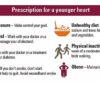Browse This Article
At least 85% of women suffer from some PMS. Which foods you eat and which you avoid can make a big difference – and let you leave the meds in the cabinet.
At least 85% of women suffer at least one premenstrual syndrom (PMS) symptom each month, according to American College of Obstetricians and Gynecologists’ estimates, from cramps to irritability to bloating. If this describes you, you may be like many women whose first thought is, “what can I take to feel better?”
Midol, or other OTC options, certainly seem like a quick fix. But are they the best one? “Midol is simply made up of acetaminophen, caffeine [which acts as a diuretic], and an antihistamine [to relieve swelling],” says Lisa Hayim, registered dietitian and founder of The Well Necessities. “There’s no magic inside these pills, or any indication that it should specifically be used for the female body. In fact, we know too much acetaminophen can damage the liver.”
[metaslider id=10435]
We asked top nutritionists what you can do to take control of your PMS before reaching for a pill.
1. Add more magnesium
“Magnesium is a mineral important for muscle contractions, which may be helpful in relieving menstrual cramps, says Mary Hartley, RD, a consulting nutritionist from Providence, RI. A 2001 Cochrane review of three small studies showed that a magnesium supplement was more effective than a placebo for cramp relief.” The mineral might also help with headache, says Erin Palinski-Wade, RD, CDE, author of Belly Fat Diet For Dummies. Definitely pump up food sources of magnesium, such as seeds, nuts, dried beans, dark green vegetables, soy products, and whole grains. But be careful with supplements, says Hartley. “Too many magnesium supplements over time can cause muscle weakness, diarrhea, abdominal cramping, the risk of kidney failure, and irregular heartbeat.”
2. Boost your mood with Vitamin B6
Brain chemicals called neurotransmitters help control mood, and vitamin B6 plays a role in creating and regulating those chemicals. “Specifically, B6 is necessary to create the myelin sheath — the insulation that surrounds the fibers that transmit nerve impulses — and to make [neurotransmitters] serotonin and norepinephrine,” explains Hayim. Studies have suggested that B6 doses of vitamin B6 up to 100 mg/day have helped with mood issues in the premenstrual period. Good sources of B vitamins include tuna, turkey, beef, chicken, and salmon, as well as sweet potatoes, spinach and bananas.
3. Go slow on your cup(s) of Joe
Got cramps? Ratcheting down the amount of caffeine you consume may help. “Caffeine constricts blood vessels, which can cause cramps,” says Kayleen St. John, RD, of the Natural Gourmet Institute, a health-supportive cooking school in New York City. No need to forgo coffee altogether, but cut down a bit and if it makes a difference. Replace some of your usual caffeine-containing beverage with decaf coffee, herbal tea or sparkling water. Caffeine may also play a role in aggravating PMS, according to some data.
4. Consume complex carbs
While simple carbs may be your enemy (think: white bread, pasta, rice), complex carbohydrates like whole grains, fruits and vegetables, are your friend right now. “These carbohydrates boost the feel-good chemical serotonin, while giving you a steady stream of energy,” explains Palinski-Wade. It’s best to have some complex carbs at every meal and snack to balance blood sugar levels and avoid the energy crashes that lead to food cravings. Great snack ideas? Popcorn, edamame or raisins.
5. Beat the bloat
Feeling the bloat as part of PMS? Avoiding some foods, and loading up on others, can make you feel a whole lot better, explains Hartley. Bloat that’s triggered by water retention is helped by “limiting sodium intake to 2,300 milligrams or less a day on the days leading up to your period,” she says. If you’re dealing with bloating in the abdomen, avoid gassy foods such as dried beans, cruciferous vegetables (cabbage, cauliflower, Brussels sprouts, and others). Lactose intolerance can also be an issue, so limit dairy to see if that helps. Scan ingredient labels on “sugar free” products for sorbitol and xylitol. These sugar alcohols contribute to bloat and stomach upset.” Finally, load up on foods with high water content. These foods — chiefly fresh fruit and veggies — are also high in fiber. “The water content helps beat bloat and puffiness while the fiber stabilizes appetite, helping to fight off those sweet cravings,” says Palinski-Wade.
6. Pump up potassium
“Diets low in potassium (known as hypokalemia) alter your body on the cellular level, and can lead to fatigue, muscle weakness and cramps, and some paralysis of your intestinal tract, which may lead to bloating, constipation and abdominal pain,” explains St. John. Getting more potassium, also called vitamin K, in your diet is as easy as eating veggies like beet greens, spinach, potatoes and fennel Bananas are also high in potassium.







